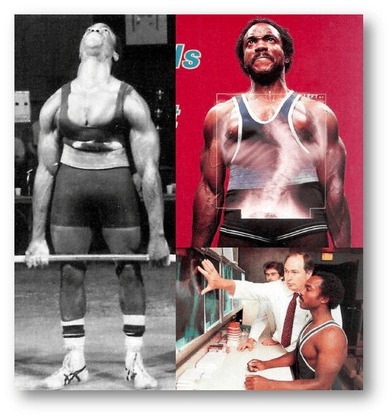|
Lamar Gant is an example of an athlete with severe scoliosis - not mild scoliosis - severe scoliosis, who overcame his limitations to become one of the most revered lifters in the annals of powerlifting. We can safely say that neither his form or technique was "textbook" (due to his morphology), and thus not what you might presume to be "safe lifting", but even so he was driven, set goals for himself, applied himself in his training, and was brave enough to stand on stage with "normal" athletes and show them what stuff he was made of.
He is not alone though, as you will find throughout the lifter forums that focus on scoliosis that many people have found that exercise - but more specifically heavy weight training - has played a complimentary role to the regression or elimination of many people's conditions. Some common themes that have turned up in this T-Nation thread are: - There seems to be no clear research done on athletes who repeatedly lift heavy weights with scoliosis and whether or not this can cause or worsen the condition. - Lift. You’ll see what happens when it happens. - Do what works for you. If it hurts(like spine damaging hurt), stop. - If you were born with it, you can prehab/rehab to keep it from getting worse, and continue lifting. If you have developed scoliosis, you can correct and reverse it with some thought and a little work. - you may develop scoliosis through bad posture, exercise selection, imbalances - unilateral work is key for addressing imbalances - lifting is good for you! Just use a little thought and consideration when you pick your lifts - An ounce of prevention is worth a pound of cure! - It wasn’t the weights that messed me up, it was the way I used the weights that caused me problems One last note: It has been said by many that "there is no correlation with bad form and injury risk in weightlifting". This is not a surprising observation as we do indeed see many examples of horrendous form performed without subsequent acute injury. Moreover, we also see (and may have experienced) instances of "perfect" form during squats, deadlifts, bench presses, etc. that incur back strains, bicep tears, or pec tears. Indeed, seldom do we see obvious positive, linear correlations of bad form and acute injury in the experimental resistance training literature. Common and well-established injury risks are actually poor sleep, high training frequency, higher training loads, exercise selection (joint specific injuries), higher rep ranges, and age is actually inversely related to injury in powerlifters, because "Despite the logical assumption that coordination and conditioning decrease with higher age, the higher experience in training and competition of older athletes led to a lower rate of injuries" (Reichel et al. 2019) So on that last note, what I'd like to leave you with is, if you are experiencing challenges with your activity - pain, discomfort, restriction, unreasonable difficulty) - give it time. There is learning in the doing, and your motor development (how your brain learns a skill and instructs your muscles) is time dependent. Be patient, trust in the process, and you will get stronger and more confident! Learn more about Lamar HERE. Research Article: Incidence and characteristics of acute and overuse injuries in elite powerlifterswww.tandfonline.com/doi/full/10.1080/2331205X.2019.1588192
0 Comments
|
NANAIMO'S BEST kettlebell group, strength & fitness classes | (250) 713-1262
CategOries
All
Archives
February 2024
|
Get Social! |
Closer Than You Think!11 Giggleswick Pl
Nanaimo, BC V9S 2V7 |


 RSS Feed
RSS Feed
